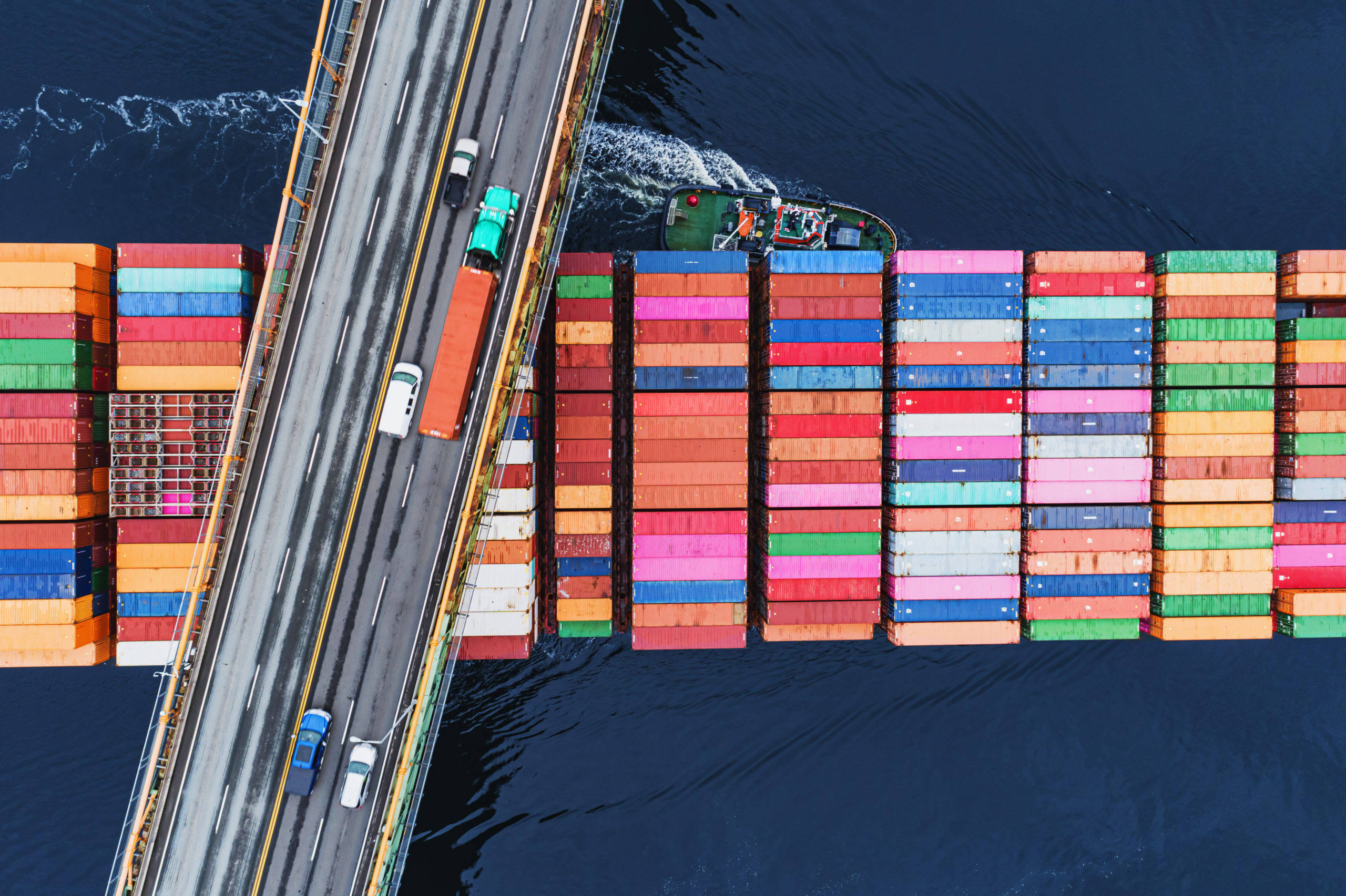What is a digital twin in supply chain?
Scroll to find out more
Scroll to find out more

Supply chain planning and execution is a complex and changing enterprise that can be challenging, even in normal conditions. But recent disruption has made the task even more difficult.
In the face of a volatile commercial, legislative and political landscape, digital twin technology is becoming increasingly invaluable for enterprises to bring their supply chains under control, as discussed by Zencargo CPTO Tamir Strauss in a recent VentureBeat article.
Digital twins – virtual representations of real-world processes – are already common for modelling industrial processes and workflows.
As an increasingly unpredictable market upsets solid-state models of supply chain planning and execution, businesses are searching for new ways to build predictability and resiliency into their processes.
The challenge for supply chain teams until now has been the ability to reliably source and compile the necessary data to create accurate models.
However, modern API technology creates the opportunity for real-time data sourcing via integration at every node of the supply chain.
Here we’ll explore the key characteristics of digital twins in supply chain, the benefits they can bring to your business and the conditions required to successfully implement one.

A digital twin in supply chain is a virtual representation of an actual supply chain, which aggregates live data to enable accurate tracking, planning, execution and modelling based on real-world events.
Supply chains are often vast, complex and stretched over long distances, generating huge volumes of data and documentation.
From an operational point of view, this makes tracking activity within the supply chain extremely challenging, limiting the ability of planners to make accurate decisions and respond to changes in market, transport or manufacturing conditions.
Strategically, teams struggle to accurately monitor and benchmark performance, preventing the ability to improve outcomes over time, or even detect systemic issues.
The advantage of digital twins is in creating a structured, analysable view of the complex physical processes that comprise the activity of a supply chain that teams can use to understand what’s really going on from the point of ordering to delivery.
Watch more on how to build smarter supply chains in this session from Navigate Smarter.
Modelling supply chain activity requires sourcing and centralising key data points across your organisation and network. These data points are the building blocks of your digital twin, with the goal of accurately reflecting current conditions so you can manage and predict activity.
These data points must include:
All of this information must be updated and maintained in real time in order to be enable accurate decision making and optimisation.

Supply chain digital twins give teams the power to track, analyse and model activity throughout their network. This makes them incredibly powerful and flexible for optimising processes – by zeroing in on the metrics in question, planners can adapt to real-time events, as well as model new solutions, measure the impact and implement changes confidently.
Key use cases include:
Supply chains involve huge numbers of stakeholders. These can include internal ones, such as buyers, merchandisers, logistics and finance departments, as well as the external transporters, manufacturers, agents and officials involved in moving the actual goods.
Most of these have only a glimpse of the information they need and it’s often out-of-date or incomplete. Digital twins create a single, unified view of the entire network, enabling teams to effectively plan and execute based on the same information.
For example, by giving buying teams access to reliable inbound goods and lead time information, they can order upcoming volumes based on more accurate inventory estimates, avoiding stockouts while balancing inventory levels.
Supply chain conditions can change rapidly, from transport delays, rate changes, manufacturing problems or customs issues. However, due to manual information gathering and a reliance on disparate systems, issues can be slow to surface, or missed entirely.
This prevents teams from being able to update plans to reflect on-the-ground conditions and exacerbates the effect of upstream disruptions on operations further down the supply chain.
At maturity, digital twins source data in real time, automatically, flagging exceptions earlier and giving teams larger windows to respond to issues. This means you have a chance to adapt plans, minimising disruption, extra costs and potential stockouts.
For example, a clearer view of activities within the supply chain might reveal that, due to manufacturing delays, ordered goods will miss the booked shipping slot. This would then postpone arrival at their destination, resulting in insufficient stocks for the big sale or launch that’s been announced by businesses weeks in advance.
Armed with this knowledge, teams can explore different approaches to avoiding this: for example, by using alternative transport modes to speed up delivery, or rerouting stock that is already in the country and is unlikely to respond to the sale.
Calculating landed costs for SKUs requires a large number of data points from multiple stakeholders, even in normal trading conditions. Meanwhile, changes in supply chain conditions often lead to extra costs, such as rebooking and D&D charges, or charges for additional storage as smooth flow from point to point gets interrupted.
By collating data holistically, teams can calculate the true cost of moving goods as well as quantifying the impact of what different stakeholders do within the supply chain.
In the short term, you might use this view to evaluate the tradeoffs between different carriers, manufacturers and routes to make better operational decisions. In the long term, planners, equipped with a fuller view of where spend is incurred, can more confidently optimise the overall cost structure of the business, without harming lead time and inventory levels.
When data isn’t captured in a structured way that facilitates proper analysis and review, it’s very difficult to build up a view of past and present supply chain activities and results that can be compared. This creates a supply chain ‘black box’ that prevents progressive improvement, leading to recurrent issues going unnoticed and damaging long-term performance.
By standardising historic data across suppliers, manufacturers, carriers and internal processes, teams can unlock before/after analysis.
This makes it easier to surface areas that might need process changes and distinguish them from one-off issues: for example, by revealing a supplier that continually delivers late, or a particular bottleneck from factory to port that regularly creates inefficiencies, extra costs and delays.
Businesses are under increasing pressure from customers, boards and regulators to reduce the impact of their operations on the environment. While raw materials, manufacturing and transport will always involve emissions, an accurate view of the environmental cost of different suppliers and options can help teams reduce any unnecessary impact.
For example, by recognizing that stock levels in warehouses seem to be sufficient to meet demand for the next few weeks, the system can recommend using ocean transportation for freight that was scheduled to be delivered by air, therefore reducing carbon emissions and costs.
To do that, it could plot new pickup routes from the factories to ports instead of airports, track the availability of space on relevant ships, and possibly even combine goods from additional manufacturers into one container to further reduce costs and environmental impact.

The main challenges for building and implementing a supply chain digital twin is making all the relevant information available, as well as having access to sufficient historical data that could be used to train the system to make the recommendations.
Getting access to manufacturers, shipping schedules, marketing plans, consumer behaviour, rail and air availability, in country stocks, etc., may present significant challenges.
Some of the key challenges are the range and variety of stakeholders and data sources or, in many cases, completely unstructured data. This includes the lack of standardisation, and the multitude of formats, systems and technologies.
Improvements are happening through the introduction of modern, API-based solutions by the incumbents such as shipping lines, with rapid changes driven by more recent players.
Platforms that consolidate data (such as Zencargo’s platform) must match data fields across multiple sources, so that there is one single ‘truth’ that can be intelligently selected depending on the trustworthiness of the sources available.
Organisations themselves also present challenges to digital twin logistics solutions. Setting up these solutions can require significant energy and resources if there’s no partner to help, and all parties need to understand both what they need to change and how it will benefit both them and the rest of the network.
On top of this, any solution must be able to adapt to the needs of different teams to create a flexible solution that can meet multiple viewpoints, no matter how complex the organisational structure, which calls for robust data architecture and management.
Zencargo has put the concept of digital twins at the heart of our supply chain management platform. Our easy-to-use, open platform is designed to integrate with a range of systems, from warehouse management to manufacturers, bringing key data into one place to enable informed, transparent decision-making and overcome the challenges of digital twins in supply chain.
With specific roles for key stakeholders within the supply chain, businesses can create tailored views that show them the information that matters to them, while connecting teams with shared visibility and the tools to turn insights into action.
To find out more about our approach to digital twins and how they can benefit your business, book a call with one of our supply chain experts.

In Focus: An update on U.S. tariffs The de minimis exemption for Chinese and Ho...

In Focus: Tariff turbulence continues to disrupt Escalation in U.S. tariff poli...
